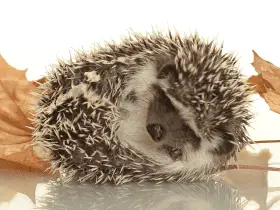Are you wondering how often to change your hedgehog cage liners? We’ve got the answers!
Regularly changing cage liners has numerous benefits, from maintaining cleanliness to promoting your hedgehog’s health. But determining the right frequency can be a challenge. That’s why we’re here to help.
In this article, we’ll delve into the factors to consider when deciding how often to change your hedgehog’s cage liners, signs that indicate it’s time for a change, and expert recommendations for optimal hygiene.
Join us as we explore the world of hedgehog care together!
Key Takeaways
- Regular cage liner changes maintain good hygiene for your hedgehog.
- The frequency of liner changes depends on factors such as cage size, activity level, odor, cleanliness, and bedding options.
- Changing fleece liners every 3-5 days is recommended to prevent odor, reduce bacteria buildup, and promote comfort for hedgehogs.
- To maintain clean cage liners between changes, remove waste daily, spot-clean spills promptly, use pet-safe cleaners, and rotate multiple liners.
Benefits of Regular Cage Liner Changes
Regularly changing the cage liners has many benefits for your hedgehog. Keeping clean and fresh bedding is essential for their overall well-being and can have a significant impact on their behavior. One of the primary benefits is that it helps maintain good hygiene for your hedgehog. By regularly replacing the cage liners, you prevent the accumulation of waste, urine, and odor, ensuring a clean environment for your pet.
Furthermore, using different cage liner alternatives can provide additional advantages. For example, fleece liners are becoming increasingly popular among hedgehog owners due to their soft texture and absorbent properties. Fleece liners not only provide comfort but also help to reduce any potential injuries caused by rough or hard surfaces.
In terms of behavior, studies have shown that regular cage liner changes contribute to a more positive environment for hedgehogs. Clean bedding promotes better sleep quality by reducing irritants such as dust mites or allergens that could affect their respiratory system. As a result, hedgehogs tend to be more active and engaged during their wakeful hours.
Overall, maintaining cleanliness through regular cage liner changes positively impacts both the physical health and behavior of your hedgehog. It ensures a comfortable living space while minimizing potential risks associated with unclean conditions.
Factors to Consider When Determining Frequency
When determining the frequency of cage liner changes for hedgehogs, there are several factors that need to be considered.
First, cage size and activity level play a significant role. Hedgehogs that have larger cages and are more active may require more frequent liner changes due to increased waste accumulation.
Additionally, odor and cleanliness should be taken into account, as a strong odor or dirty environment can negatively impact the hedgehog’s health and well-being.
Cage Size and Activity
You should consider the size of your hedgehog’s cage and its activity levels when deciding how often to change the cage liners. Hedgehogs require a certain amount of space for their physical and mental well-being, so it is important to provide them with an adequately sized enclosure. Additionally, their activity levels can vary from hedgehog to hedgehog, with some being more active than others.
Taking these factors into account will help you determine how frequently you need to change the cage liners to maintain a clean and healthy living environment for your pet.
Here are some key points to consider:
- Cage enrichment: Providing your hedgehog with various forms of stimulation such as tunnels, wheels, and toys can increase their activity levels and encourage exploration.
- Bedding options: The type of bedding you choose can affect how quickly it becomes soiled. Some options like fleece liners or paper-based bedding may need more frequent changing compared to wood shavings.
- Monitor cleanliness: Regularly check the condition of the cage liners for any signs of odor or excessive waste buildup.
- Hedgehog habits: Observe your hedgehog’s behavior patterns to determine if they tend to use specific areas in the cage more frequently, which may require more frequent liner changes.
Odor and Cleanliness
To maintain a fresh and hygienic environment for your hedgehog, it’s important to regularly monitor the odor and cleanliness of their cage. A clean and odor-free cage not only promotes a healthy living space for your pet but also ensures their overall well-being.
One effective way to control odor is by using bedding in the cage. Bedding absorbs moisture and helps reduce unpleasant smells caused by urine or feces. It also provides a comfortable surface for your hedgehog to burrow and nest in. Some popular bedding options include aspen shavings, paper-based bedding, or fleece liners that can be easily washed and reused.
However, if you prefer not to use bedding, there are alternative liner options available such as puppy pads or washable rugs. These options provide an absorbent surface while being easy to clean and maintain.
Ultimately, choosing the right bedding or liner option depends on your preference and what works best for you and your hedgehog’s needs.
Signs That Indicate It’s Time to Change the Liners
It’s important to be aware of certain signs that indicate it’s time to change the liners in your hedgehog’s cage. Regularly replacing the liners not only ensures a clean and odor-free environment for your pet but also promotes their overall health and well-being.
Here are some key indicators that it may be time for a liner change:
Strong Odor: If you notice a persistent, unpleasant smell coming from the cage, it’s likely due to dirty liners that need to be replaced.
Stains or Discoloration: Over time, liners can become stained or discolored from urine and feces. This is a clear sign that they need to be swapped out for fresh ones.
Excessive Dirtiness: When the liners appear visibly dirty or soiled, it’s an indication that they have reached their limit and should be changed promptly.
Worn-out Liners: If you observe fraying edges, holes, or tears in the liners, they have likely deteriorated beyond use and must be replaced.
In terms of alternative options for cage liners, reusable liners offer several benefits. They are environmentally friendly as they reduce waste generated by disposable options. Additionally, reusable liners are cost-effective since you won’t have to constantly buy new ones.
Some alternatives include fleece blankets or towels that can easily be washed and reused. Remember to choose materials that are safe for your hedgehog and provide adequate absorbency to keep their habitat clean and comfortable.
The Impact of Dirty Cage Liners on Hedgehog Health
Dirty cage liners can have a negative impact on the overall health of your hedgehog. Maintaining a clean environment for your pet is essential to ensure their well-being and prevent potential health risks.
When cage liners are dirty, they create an ideal breeding ground for bacteria, fungi, and parasites that can harm your hedgehog. These harmful organisms thrive in damp and dirty environments, leading to various health issues.
A dirty cage can result in skin infections, respiratory problems, and gastrointestinal disturbances in hedgehogs. Skin infections are common when hedgehogs come into contact with soiled bedding or urine-soaked liners. Bacteria present in the dirt can enter through small cuts or abrasions on their skin, causing redness, swelling, and discomfort.
Respiratory problems are another concern associated with dirty cages. Dust particles from soiled bedding or accumulated waste can be inhaled by your pet, leading to respiratory distress and even pneumonia. Hedgehogs are prone to developing upper respiratory infections if exposed to unclean conditions for extended periods.
Furthermore, a filthy environment increases the risk of gastrointestinal disturbances for your hedgehog. Consuming contaminated food or water due to unsanitary conditions may cause digestive issues such as diarrhea or constipation.
To provide a safe living space for your hedgehog and minimize these health risks, it is crucial to regularly change the cage liners and keep their habitat clean. This practice promotes a healthier environment where bacteria and parasites cannot thrive, ensuring the well-being of your beloved pet.
How Often Should You Change Paper-Based Liners
Maintaining a consistent schedule for replacing paper-based liners is essential for ensuring the cleanliness and hygiene of your hedgehog’s living space. Regularly changing the liners not only keeps your hedgehog healthy, but also provides several other benefits:
Odor Control: Paper-based liners are highly absorbent and help to control odors in the cage. By changing them regularly, you can prevent unpleasant smells from permeating your home.
Easy Cleanup: Paper-based liners make cleaning a breeze. Simply remove and replace the soiled liner, eliminating the need for extensive scrubbing or washing.
Reduced Bacterial Growth: Changing liners frequently helps to minimize bacterial growth in the cage. This decreases the risk of infections and promotes better overall health for your hedgehog.
Comfortable Environment: Hedgehogs love burrowing into soft bedding materials. Paper-based liners provide a cozy and comfortable surface for them to rest on.
While paper-based liners offer numerous advantages, there are alternative options available as well. Some alternatives include fleece blankets or towels that can be easily washed and reused, or specialized cage mats designed specifically for small animals.
How Often Should You Change Fleece Liners
When it comes to fleece liners, determining the optimal change frequency is crucial for maintaining a clean and healthy environment for your pets. Regular changes are beneficial not only for the comfort and hygiene of your furry friends but also for odor control and prevention of bacteria buildup.
Optimal Liner Change Frequency
To keep your hedgehog’s cage fresh and clean, you should consider changing the liners regularly. Maintaining a clean environment is crucial for your hedgehog’s health and well-being. Here are some reasons why cleanliness is important:
- Preventing odor: Regular liner changes help to minimize unpleasant smells in the cage.
- Reducing bacteria: Dirty liners can harbor harmful bacteria that can lead to infections or diseases.
- Promoting comfort: Clean liners provide a comfortable surface for your hedgehog to walk on or rest.
- Maintaining hygiene: Fresh bedding helps prevent skin irritations and keeps your hedgehog’s coat clean.
The optimal frequency of liner changes may vary depending on factors such as the size of the cage, the number of hedgehogs, and their individual habits. However, it is generally recommended to change fleece liners every 3-5 days to ensure cleanliness and hygiene for your furry friend.
Benefits of Regular Changes
Now let’s talk about the benefits of frequent changes when it comes to hedgehog cage liners.
Regularly changing your hedgehog’s cage liner has numerous hygienic benefits that contribute to their overall well-being.
Firstly, it helps maintain a clean and odor-free environment for your pet. Hedgehogs are known for their strong scent, and by changing the liner often, you can minimize any unpleasant smells in their living space.
Secondly, frequent changes help prevent the buildup of bacteria and fungi that could potentially harm your hedgehog’s health. These organisms thrive in damp environments, so replacing the liner regularly ensures a dry and sanitary habitat for your pet.
Lastly, regular changes also make it easier to monitor your hedgehog’s litter box habits and identify any potential health issues early on. It allows you to keep track of their waste patterns and spot any abnormalities or signs of illness promptly.
Tips for Maintaining Clean Cage Liners Between Changes
Make sure you regularly spot-clean your hedgehog’s cage liners to keep them fresh and odor-free. Maintaining cleanliness is essential for the health and well-being of your hedgehog, as it helps prevent the buildup of bacteria and unpleasant odors.
Here are some tips to help you maintain clean cage liners between changes:
Remove waste daily: Hedgehogs are known for their impeccable bathroom habits, so removing any droppings or soiled bedding on a daily basis will go a long way in preventing odor.
Spot-cleaning spills: Accidents happen, but quickly attending to any spills or wet spots on the cage liner can help prevent bacterial growth and minimize odors.
Use pet-safe cleaners: When spot-cleaning or washing the entire liner, make sure to use pet-safe cleaners that do not contain harsh chemicals. This ensures the safety of your hedgehog while effectively eliminating odors.
Rotate multiple liners: Having multiple sets of cage liners allows you to rotate them while cleaning, ensuring that your hedgehog always has a fresh and clean surface to walk on.
Common Mistakes to Avoid When Changing Cage Liners
When it comes to maintaining cage liners, proper maintenance is crucial for the overall hygiene of the enclosure. This includes regular cleaning and disinfection to prevent the buildup of bacteria and odors.
Additionally, using suitable liner materials that are easy to clean and absorbent can greatly contribute to maintaining a clean and odor-free environment for our pets.
It’s important to emphasize the importance of hygiene in order to ensure the health and well-being of our furry friends.
Proper Liner Maintenance
To ensure proper liner maintenance for your hedgehog’s cage, you should regularly check for any soiled areas and replace them promptly. This will help keep your hedgehog’s living space clean and hygienic.
When it comes to selecting the right liner for your hedgehog’s cage, there are a few factors to consider. Firstly, choose a liner that is absorbent and easy to clean. Fleece liners are a popular choice as they are soft, comfortable, and can be easily washed. Secondly, make sure the liner fits the size of the cage properly to prevent any gaps or loose edges where waste can accumulate.
In terms of cleaning techniques, it is recommended to spot-clean soiled areas daily by removing any waste with a scoop or tissue paper. Once a week, remove the entire liner and wash it thoroughly using mild detergent and hot water. Avoid using harsh chemicals or bleach as these can irritate your hedgehog’s skin. Finally, remember to dry the liner completely before placing it back in the cage.
Suitable Liner Materials
Now that we understand the importance of proper liner maintenance, let’s discuss suitable materials for your hedgehog’s cage. Choosing the right liner material is crucial for maintaining proper hygiene and ensuring your pet’s comfort.
When it comes to suitable liner materials, there are a few options to consider. One popular choice is fleece fabric, which provides a soft and cozy surface for your hedgehog to walk on. Fleece liners are also washable and reusable, making them cost-effective in the long run.
Another option is waterproof liners made from PVC or other similar materials. These liners are easy to clean and can prevent any liquid from seeping through to the bottom of the cage.
It’s important to note that whatever material you choose, it should be non-toxic and safe for your hedgehog. Avoid using materials with loose threads or fibers that could pose a risk of entanglement.
Hygiene Importance
Maintaining proper hygiene is crucial for creating a clean living environment for your hedgehog. Regular cleaning not only keeps your hedgehog healthy, but it also helps prevent any unpleasant odors in your home. Here are some hygiene tips and cleaning techniques to ensure the well-being of your spiky friend:
- Spot clean regularly: Remove any soiled bedding or droppings daily to keep the cage fresh.
- Change liners weekly: Replace the fleece liners or other bedding materials once a week to maintain cleanliness.
- Disinfect with pet-safe cleaners: Use mild detergents or pet-safe disinfectants when thoroughly cleaning the cage to eliminate bacteria and germs.
- Air dry properly: Allow all items, such as toys and accessories, to completely air dry before placing them back into the cage.
The Role of Proper Hygiene in Hedgehog Cage Care
Make sure you’re aware of the importance of proper hygiene when taking care of your hedgehog’s cage. Regular cleaning is crucial for maintaining a healthy and comfortable environment for your pet. Hedgehogs are prone to bacterial infections, so it’s essential to take preventive measures to avoid any potential health issues.
Regularly cleaning your hedgehog’s cage helps prevent bacterial growth and keeps the habitat clean and odor-free. The buildup of waste, food debris, and urine can create a breeding ground for bacteria if not removed promptly. We recommend daily spot cleaning by removing any visible waste or soiled bedding.
In addition to spot cleaning, it is necessary to perform a thorough deep clean on a regular basis. This involves completely emptying the cage, disinfecting all surfaces with a hedgehog-safe cleaner, and replacing all bedding materials. The frequency of deep cleaning depends on various factors such as the size of the cage, number of hedgehogs, and their habits. Generally, performing a deep clean every 1-2 weeks is recommended.
To further prevent bacterial growth in your hedgehog’s cage, ensure that you use appropriate bedding materials that are absorbent and easy to clean. Avoid using cedar or pine shavings as they can release harmful chemicals and cause respiratory problems for your pet.
Expert Recommendations for Cage Liner Changes
Regularly replacing the liner in your hedgehog’s cage is recommended by experts to ensure a clean and comfortable living environment. There are several factors to consider when determining how often you should change the cage liner.
These factors include:
Hedgehog’s activity level: If your hedgehog is highly active and spends a lot of time in its cage, the liner may need to be changed more frequently.
Liner material: Certain materials, such as fleece or fabric liners, tend to hold onto odors and waste more than others. These liners may need to be changed more often.
Cage size: The larger the cage, the less frequently the liner will need to be changed since there is more space for your hedgehog to move around and distribute waste.
Hedgehog’s health condition: If your hedgehog has any health issues that result in increased urination or fecal output, it may be necessary to change the liner more frequently.
Failing to regularly change the cage liner can have a significant impact on your hedgehog’s health. Dirty liners can harbor bacteria and parasites, leading to infections or other health problems. Additionally, ammonia from urine buildup can irritate their respiratory system.
Frequently Asked Questions
Can I Use a Different Type of Liner, Such as Wood Shavings, Instead of Paper-Based or Fleece Liners?
We can use wood shavings as an alternative to paper-based or fleece liners for hedgehog cages. There are pros and cons to consider, such as absorbency and dustiness. As for how often cage liners should be changed, it’s important for hedgehog health to do so regularly.
What Are Some Alternatives to Cage Liners for Hedgehog Cages?
When it comes to hedgehog cage liners, there are alternatives worth considering. These options can help limit bacterial growth and potential allergies. Let’s explore some creative solutions for keeping our hedgies comfy and healthy!
How Do I Properly Clean and Sanitize Cage Liners Before Reusing Them?
We’ve found that proper cage liner maintenance is key to keeping our hedgehog’s habitat clean and healthy. We choose cleaning products specifically designed for hedgehog cage liners and follow the manufacturer’s recommendations for sanitizing before reusing them.
Can I Use Scented Cleaning Products or Disinfectants on the Cage Liners?
Using scented cleaning products on cage liners may pose risks to hedgehogs, as they have sensitive respiratory systems. Disinfectants can be used sparingly, ensuring proper rinsing and drying to avoid any potential harm.
Are There Any Specific Hedgehog Health Conditions That May Require More Frequent Cage Liner Changes?
Specific hedgehog health conditions, such as respiratory infections or skin irritations, may require more frequent cage liner changes. These conditions can lead to increased soiling of the liners and potential bacterial growth, necessitating regular cleaning to maintain a healthy environment for your hedgehog.
Conclusion
In conclusion, folks, it’s clear that changing your hedgehog’s cage liners is no joke. The benefits of regular changes are undeniable – from maintaining hygiene to preventing health issues.
While determining the frequency may seem like a daunting task, keeping an eye out for signs like odor and soiled liners can guide you. Experts recommend paper-based liners be changed every 3-4 days, ensuring a clean and cozy space for your prickly pal.
Remember, proper hygiene is key, so don’t hedge on keeping those cages fresh!




















Leave a Reply
View Comments